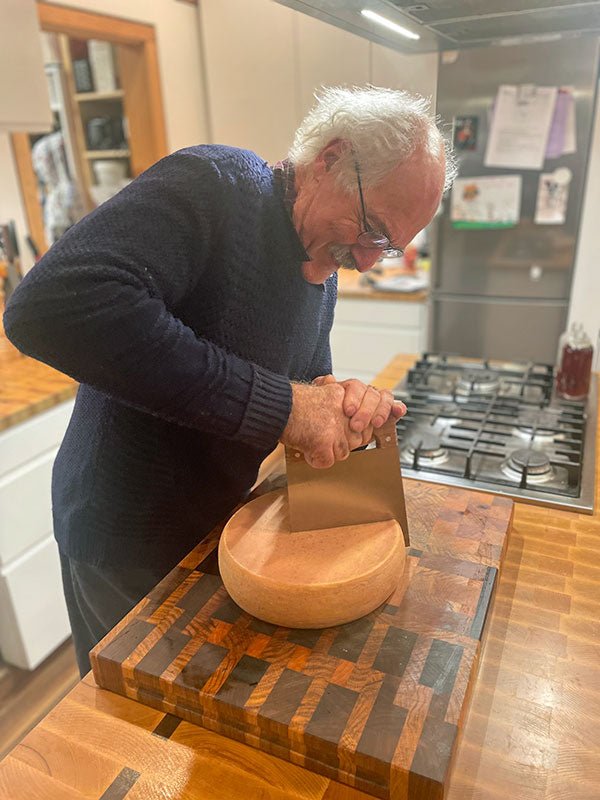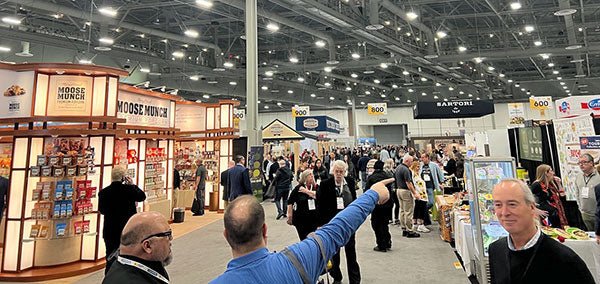
Rita with her old Springer, Farley (14 1/2) and her pup, Abby (4 months) on a camping trip to Quadra Island off the east coast of Vancouver Island last June.
I live in the beautiful Cowichan Valley on Vancouver Island in British Columbia, Canada.
My partner and I have just under an acre surrounded by farms and vineyards. We live there with our 4 dogs (3 Brittanys under 2 and an old Springer spaniel who is 15) and a cat.
We have fruit trees, berry bushes and a large vegetable and herb garden. We process as much of the produce as we can and give fruits and vegetables to our families and friends.
 It’s always fun to be able to serve friends and family food that we grew ourselves or that came from neighbouring farms!
It’s always fun to be able to serve friends and family food that we grew ourselves or that came from neighbouring farms!
I’d been intrigued by the idea of making cheese for a few years. I’d made yoghurt on and off over the past 40 or so years, but it never occurred to me that it was a similar process.
In the summer of 2020, I was chatting with a neighbour who had just bought a Jersey cow. She was telling me that she was making cheese and butter, and of course drinking that delicious milk. That got me going!
I searched the internet and found some very helpful sites, and bought my first couple of kits. I think I made my first cheese in the fall of 2020 – a mozzarella which of course didn’t stretch, but I was hooked anyway!
That spurred me on to more research and a couple of books on cheesemaking and more research and blogs and Facebook groups such as Artisan Cheesemakers and Learn to Make Cheese.
I used milk from the grocery store, including goat’s milk, until I found a local dairy – Cowichan Milk Company – that was selling cow’s milk at their farm gate – low temperature pasteurized, cream top milk!

Creme Fraiche and buttermilk. I use the buttermilk for baking – pancakes, waffles, coffee cakes, etc. The crème fraiche is a lovely replacement for sour cream. It is made with whipping cream.
I was pretty excited to find it and and love using their milk. I’d love a more local source of goat’s milk, too.
Last year another local dairy also started selling milk from their Guernsey cows at their farm gate – 6% milk which will be lovely for those high fat cheeses and delicious yoghurt.
Just before Christmas 2021, my neighbor became ill and was not able to process all the milk her cow was giving. We made an arrangement whereby I made cheese with her milk and gave half of it back to her.
I also baked sourdough bread for her, so I made a lot of cheese in January and February 2022 – 2-3 16 litre (4 gallon) batches a week.

Fresh bread and cheese. Clockwise from the left is Komijne Kaas, bloomy rind cow’s milk, and a washed rind surface-ripened cheese similar to St. Paulin
I made gouda style cheese, spiced gouda, cheddars, including a cheddar in stout that I have yet to open, butterkase, Brie and Camembert styles, muenster style, tomme, bloomy rind cheeses (cow and goat), extra hard washed rind, Gruyère style, havarti style, Caerphilly; and yes, I tried mozzarella again and it stretched beautifully and tasted delicious on our pizzas (and with tomatoes and fresh basil from the garden).
I made vegetable ash from grapevines in our garden and used them with some of the goat milk bloomy rind cheeses.
Directions for making the ash: Wash and wrap grapevines in aluminum foil and “cook” them on the barbecue grill, or in a fireplace or wood stove. The amount of time it takes will depend on the thickness of the grapevines. You want to use the woody vines as opposed to the more green vines near the end of each vine. You will know they are done when you open the foil pouch and see charcoal sticks. These are then ground.
When I first started making cheese, I could age it in my pantry which is a well-insulated space that holds a constant temperature. However, we’ve seen some significant hot spells in the summers during which the pantry also heated up.
Now, I use a wine fridge as a cheese cave, and my partner made wooden shelves for it. I was allowing natural rinds to develop, but had to vacuum seal them all in August as we were heading out on a 6 week camping trip and wouldn’t be able to maintain the rinds.
I love my press –
After learning to make cheese, I applied some of my cheesemaking techniques to making yoghurt. It occurred to me when I was making whey ricotta that the yoghurt will also benefit from being heated to as high as possible! I heat the milk in glass jars in a pot in the stove until it is almost boiling (makes clean up so much easier!).
Once it’s cooled and I’ve added the culture, I place the jars in a water bath heated with an immersion heater. My yogurt is generally nice and thick and tastes wonderful with berries, a dollop of the neighborhood honey and homemade granola with dried fruit.
The next types of cheeses that I want to make are the blue cheeses – I just haven’t been brave enough for the consequences of having those strains in my cave, although I could dedicate the top of the fridge to the blues and the lower section to the other cheeses. I am also really enjoying the aged cheeses with the natural rinds, so, want to ensure that I always have cheeses aging for the longer term.

On the left is an extra hard washed curd (parmesan) from January 2021 and on the right a hard cheese with small eyes (gruyere) also from January 2021. Both were aged naturally for about 6 months until I vac packed them for the trip I mentioned above.
I also want to learn to cure more kinds of meats and sausages, but would require another storage space!
































































































































































